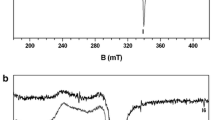Abstract
A set of raw industrial materials, that is, pure quartz and quartz-rich mixtures, were investigated through electron paramagnetic resonance and electron spin echo-envelope modulation spectroscopies, with the aim of evaluating the effective role played by defect centres and of assessing whether they can be used to monitor changes in the physical properties of quartz powders with reference to their health effects. The obtained results point to two interactions of the Al defect centres with H+, hosted in sites within the channels parallel and perpendicular to the c axis of quartz, respectively. These two Al/H+ (hAl) centres exhibit a weak chemical bond, and their relative amounts appear to be modified/controlled by the thermo-mechanical processes underwent by powders. Indeed, a mechanically promoted inter-conversion between the two kinds of site is suggested. As a consequence, the hAl centres are effective in monitoring even modest activations of powders, through thermal or mechanical processes, and they are also supposed to play a specific, relevant role in quartz reactivity during the considered industrial processes.








Similar content being viewed by others
References
Botis SM, Pan Y (2009) Theoretical calculations of [AlO4/M+]0 defects in quartz and crystal-chemical controls on the uptake of Al. Mineral Mag 73(4):537–550
Cakmak GD, Schins RPF, Shi T, Fenoglio I, Fubini B, Borm PJA (2004) In vitro genotoxicity assessment of commercial quartz flours in comparison to standard DQ12 quartz. Int J Hyg Environ Health 207:105–113
Carnevale F, Capacci F, Di Benedetto F (2010) Silice Libera Cristallina nei Luoghi di Lavoro. Giunti Organizzazioni Speciali, Firenze
Dikanov SA, Tsvetkov YuD (1992) Electron spin echo envelope modulation (ESEEM) spectroscopy. CRC Press, Boca Raton
Donaldson K, Borm PJA (1998) The quartz hazard: a variable entity. Ann Occup Hyg 42(5):287–294
Fubini B, Otero Aréan C (1999) Chemical aspects of the toxicity of inhaled mineral dusts. Chem Soc Rev 28:373–381
Glerup J, Weihe H (1991) Magnetic susceptibility and EPR spectra of l-cyano-bis[pentaaminechromium(III)] perchlorate. Acta Chem Scand 45(5):444–448
Götze J, Plötze M, Graupner T, Hallbuer DK, Bray CJ (2004) Trace element incorporation into quartz: a combined study by ICP-MS, electron spin resonance, cathodoluminescence, capillary ion analysis, and gas chromatography. Geochim Cosmochim Acta 68(18):3741–3759
Götze J, Plötze M, Trautmann T (2005) Structure and luminescence characteristics of quartz from pegmatites. Am Mineral 90(1):13–21
Harrison WA (1999) Elementary electronic structure. World Scientific Publishing, Singapore
Ikeya M (1993) New applications of electron paramagnetic resonance: ESR dating, dosimetry, and spectroscopy. World Scientific, Singapore
Lide DR (1998) CRC handbook of chemistry and physics. CRC Press, Boca Raton
Lutterotti L, Ceccato R, Dal Maschio R, Pagani E (1998) Quantitative analysis of silicate glass in ceramic materials by the Rietveld method. Mater Sci Forum 278–281:93–98
Mackey JH, Boss JW, Wood DE (1970) EPR study of substitutional-aluminum-related hole centers in synthetic α-quartz. J Magn Reson 3:44–54
Nuttall RHD, Weil JA (1981a) The magnetic properties of the oxygen-hole aluminum centres in crystalline SiO2. I. [AlO4]0. Can J Phys 59:1696–1708
Nuttall RHD, Weil JA (1981b) The magnetic properties of the oxygen-hole aluminum centres in crystalline SiO2. II. [AlO4/H+]+ and [AlO4/Li+]+. Can J Phys 59:1709–1718
Straif K, Benbrahim-Tallaa B, Baan R, Grosse Y, Secretan B, El Ghissassi F, Bouvard V, Guha N, Freeman C, Galichet L, Cogliano V (2009) A review of human carcinogens—part C: metals, arsenic, dusts, and fibres. Lancet Oncol 10:453–454
Weil JA (1984) A review of electron spin spectroscopy and its application to the study of paramagnetic defects in crystalline quartz. Phys Chem Miner 10(4):149–165
WHO-IARC (1997) IARC monographs on the evaluation of carcinogenic risks to humans. Vol. 68: Silica, some silicates, coal dust and para-aramid fibrils. IARC, Lyon
Acknowledgments
The manuscript benefited of the precious comments and discussions on the crystal chemistry of the Al centres by Francesco D’Acapito of the CNR-IOM-OGG (ESRF, Grenoble, France), to whom the authors are indebted. Authors are also indebted to L. Pellicci of the Ce.Ri.Col. Laboratory for the granulometry investigations and to E. Bafaro of the Local Environmental Agency of Florence (ARPAT) for the help in sampling procedures. The sampling procedures were enabled and greatly assisted by the Health Surveillance Operators of the Local Health Agencies of Tuscan Units. The authors acknowledge the Tuscany Administration for funding this research under the programmes “Progetto di ricerca per l’individuazione delle cause di variazione della reattività superficiale della silice cristallina, nei principali comparti di lavoro toscani, in relazione alla sua potenziale patogenicità” and “Progetto di ricerca per il controllo del rischio d’esposizione a silice libera cristallina (SLC) nei comparti lavorativi toscani, lo studio delle proprietà chimico-fisiche, morfologiche e biologiche delle polveri silicee in diversi comparti produttivi e lo studio dei meccanismi patogenetici e degli effetti dell’esposizione anche a basse dosi”. The MIUR (Italy) is also acknowledged for the PRIN 2008 project prot. 2008N7CYL5, as well as Italian CNR, for support. The manuscript benefited of the stimulating review by Y. Pan and an anonymous reviewer to whom authors express their warmest thanks.
Author information
Authors and Affiliations
Corresponding author
Electronic supplementary material
Below is the link to the electronic supplementary material.
Rights and permissions
About this article
Cite this article
Romanelli, M., Di Benedetto, F., Bartali, L. et al. ESEEM of industrial quartz powders: insights into crystal chemistry of Al defects. Phys Chem Minerals 39, 479–490 (2012). https://doi.org/10.1007/s00269-012-0502-3
Received:
Accepted:
Published:
Issue Date:
DOI: https://doi.org/10.1007/s00269-012-0502-3




